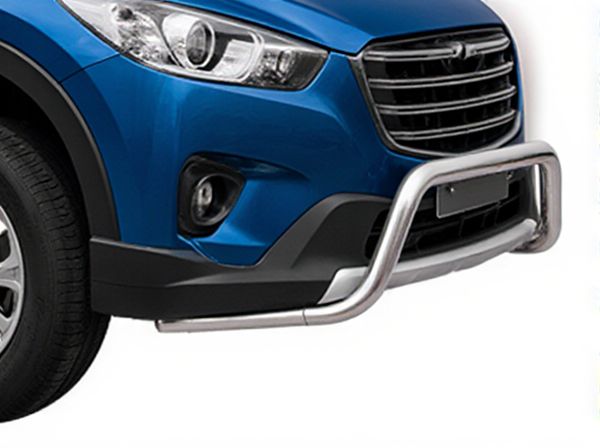
Photo illustration: Fascia bumper vs Impact bar bumper
Fascia bumpers provide a sleek, aesthetic outer layer that enhances your vehicle's appearance while offering basic protection against minor impacts. Impact bar bumpers are designed with a reinforced metal or composite bar underneath the fascia, delivering superior strength and better energy absorption during collisions. Understanding the difference helps you choose the right bumper for both style and safety needs.
Table of Comparison
| Feature | Fascia Bumper | Impact Bar Bumper |
|---|---|---|
| Material | Plastic or fiberglass | Steel or aluminum |
| Function | Exterior styling and minor impact absorption | Structural impact absorption and collision protection |
| Durability | Moderate, prone to cosmetic damage | High, designed to absorb heavy impact |
| Cost | Lower replacement cost | Higher repair and replacement cost |
| Weight | Lightweight | Heavyweight |
| Installation | Attached to front/rear, covers impact bar | Mounted behind fascia, integral to chassis safety |
| Repair Complexity | Easy to repair or replace | Requires professional handling due to structural role |
Introduction to Fascia and Impact Bar Bumpers
Fascia bumpers consist of a lightweight plastic cover designed primarily for aesthetic purposes and minor impact absorption, seamlessly integrating with a vehicle's exterior styling. Impact bar bumpers incorporate a robust steel or aluminum beam positioned behind the fascia, providing enhanced structural protection by absorbing and distributing collision forces. These components work in tandem where the fascia offers cosmetic appeal while the impact bar delivers critical safety performance during low-speed impacts.
Key Differences Between Fascia and Impact Bar Bumpers
Fascia bumpers are exterior panels primarily designed for aesthetic appeal and minor impact absorption, often made from plastic or composite materials. Impact bar bumpers are structural components located behind the fascia, engineered from metal or reinforced materials to absorb and distribute crash forces, enhancing vehicle safety. Unlike fascia bumpers, impact bars play a critical role in minimizing damage during collisions by reinforcing the vehicle's front or rear end.
Material Composition of Fascia vs Impact Bar Bumpers
Fascia bumpers are typically made from lightweight thermoplastic materials such as polypropylene or polyurethane, designed to provide aerodynamic styling and minor impact absorption. Impact bar bumpers consist of metal or reinforced steel bars, often combined with foam or plastic energy absorbers, engineered to withstand higher collision forces and protect structural components. The material composition of fascia bumpers emphasizes flexibility and aesthetic integration, whereas impact bar bumpers prioritize durability and crash energy management.
Design and Aesthetic Features
Fascia bumpers offer a seamless, streamlined design that integrates smoothly with a vehicle's body, enhancing aerodynamic efficiency and modern aesthetic appeal. Impact bar bumpers emphasize functionality with a visible, sturdy metal bar designed to absorb impacts, often resulting in a more rugged, utilitarian look. Fascia bumpers are preferred in contemporary car designs for their sleek appearance, while impact bar bumpers prioritize durability over style.
Performance in Collision Protection
Fascia bumpers are designed primarily for aesthetic appeal and minor collision protection, absorbing low-impact forces through flexible materials and minimizing surface damage. Impact bar bumpers, composed of reinforced steel or aluminum bars, provide superior energy absorption and structural rigidity, significantly enhancing occupant safety during moderate to high-speed collisions. Vehicle safety performance tests consistently show impact bar bumpers reduce frame deformation and distribute collision forces more effectively than fascia bumpers alone.
Installation and Maintenance Considerations
Fascia bumpers offer simpler installation as they are typically designed as a single piece that fits directly onto the vehicle's frame, reducing labor time and costs. Impact bar bumpers require more effort during installation due to their separate steel reinforcement bars that must be securely mounted behind the bumper cover for proper impact absorption. Maintenance of fascia bumpers tends to involve replacing the entire cover if damaged, whereas impact bar bumpers allow for easier repair or replacement of individual components, enhancing long-term durability and cost-effectiveness.
Cost Comparison: Fascia vs Impact Bar Bumpers
Fascia bumpers typically cost more than impact bar bumpers due to their integrated design and the need for precise fitment with vehicle body panels. Impact bar bumpers generally have lower material and installation costs, as they primarily focus on structural protection without extensive cosmetic components. Budget-conscious buyers often prefer impact bar bumpers, while fascia bumpers are favored for their aesthetic appeal despite higher expenses.
Durability and Longevity
Fascia bumpers, made primarily from plastic or composite materials, offer lightweight protection but tend to wear down faster under harsh impacts, leading to potential cracking or deformation over time. Impact bar bumpers, constructed from steel or aluminum, provide superior strength and resistance to dents, enhancing vehicle durability and extending bumper lifespan significantly. The metal framework of impact bar bumpers better absorbs collision forces, reducing structural damage and maintaining long-term reliability compared to fascia-only bumpers.
Safety Standards and Regulations
Fascia bumpers are designed primarily for aesthetic integration and minor impact absorption, complying with pedestrian safety standards such as the Euro NCAP regulations. Impact bar bumpers, typically constructed from reinforced steel or aluminum, meet stringent safety regulations like FMVSS 581 in the US by providing superior energy absorption and protection during moderate collisions. Both components must adhere to specific crash test protocols ensuring occupant and pedestrian safety, but impact bar bumpers offer enhanced structural integrity aligned with regulatory compliance for impact resistance.
Choosing the Right Bumper for Your Vehicle
When choosing the right bumper for your vehicle, consider that fascia bumpers provide a sleek, aerodynamic design with integrated safety features ideal for modern cars, while impact bar bumpers offer robust protection by absorbing and distributing collision forces. Fascia bumpers, made from lightweight plastic materials, enhance fuel efficiency and aesthetics but may require costly repairs after minor impacts. Impact bar bumpers, often constructed from steel or aluminum, prioritize durability and crash safety, making them suitable for heavy-duty vehicles and those frequently driven in rugged environments.
 caratoz.com
caratoz.com